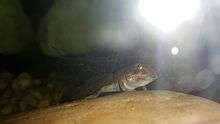Trilling frog
| Trilling Frog | |
|---|---|
| Scientific classification | |
| Kingdom: | Animalia |
| Phylum: | Chordata |
| Class: | Amphibia |
| Order: | Anura |
| Family: | Myobatrachidae |
| Genus: | Neobatrachus |
| Species: | N. centralis |
| Binomial name | |
| Neobatrachus centralis Parker, 1940 | |

The Trilling Frog or Desert Trilling Frog (Neobatrachus centralis) is an Australian burrowing frog, of the family Myobatrachidae.
Distribution
The Trilling frog is found throughout the central Australian deserts in a band encompassing South Australia and Western Australia. It is remarkable in its toleration for arid environments.
Description
The Trilling Frog is a medium-sized short, fat frog (5 centimetres measured from snout to posterior), usually of a brown and tan colour with sharply differentiated mottling, much like army desert camouflage. This frog is white underneath. The pupil of this frog contracts to a vertical slit. The dorsal surface is usually smooth, however it is reported that during the breeding season, the males develop fine, dark bristles on their back. The Trilling Frog can be differentiated from The Painted Frog (Neobatrachus pictus) by the 'baggy pants' of loose skin that extends almost to their knees when the hind legs are extended
Ecology and behaviour
The Trilling frog is adapted to desert conditions and can spend years without having to surface, buried deep underground with their glands under the skin full of water. The Trilling Frogs will commonly dig themselves to the surface at the beginning of the late summer rains. There are stories that to prevent death by thirst, Indigenous Australians could catch these frogs by cleverly stamping on the right patch of ground to simulate thunder or falling rain, causing the frogs would surface where they could then be made to give up their stored moisture. These frogs will spend a few weeks calling nightly while floating in or sitting at the edge of rainwater filled claypans, puddles and waterholes. DEH, Trilling Frog Call
They eat the numerous insects accompanying the rains and lay eggs in drawn out clumps, often wrapped around snags in the water. The tadpoles mature very quickly.
Like most Australian frogs, the Trilling Frog is an opportunistic predator and so the diet of the species consists mostly of any desert dwelling insects and reptiles small enough to fit in its mouth. In some areas it is the only ground living vertebrate collected.
Genetics
This interesting little frog is a tetraploid organism, having double the normal number of chromosomes. Recently results of molecular biology analysis have caused some speculation that this may be the same species as Neobatrachus sudelli (Roberts (1997))
References
- Hero & Roberts (2004). Neobatrachus centralis. 2006. IUCN Red List of Threatened Species. IUCN 2006. www.iucnredlist.org. Retrieved on 24 Nov 2006. Database entry includes a range map and justification for why this species is of least concern
- Cogger, H.G. 1979. Reptiles & Amphibians of Australia. A. H. & A. W. REED PTY LTD ISBN 0-589-50108-9
- Mahony MJ, Robinson ES. Polyploidy in the Australian leptodactylid frog genus Neobatrachus.. 1: Chromosoma. 1980;81(2):199-212.
- J. L. Read, Abundance and recruitment patterns of the trilling frog (Neobatrachus centralis) in the Australian arid zone. Australian Journal of Zoology 47(4) 393 - 404
- Tyler, M.J. 1994. Australian Frogs A Natural History. Reed Books ISBN 0-7301-0468-0
- Anstis, M. 2002. Tadpoles of South-eastern Australia. Reed New Holland: Sydney.
- DEH Frogs of SA > Neobatrachus centralis
